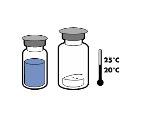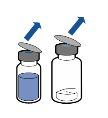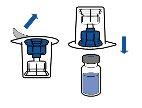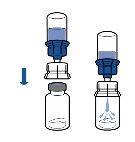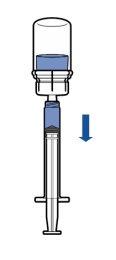
ВІЛФАКТ 1000 МО ПОРОШОК І РОЗЧИННИК ДЛЯ ПРИГОТУВАННЯ ІН'ЄКЦІЙНОГО РОЗЧИНУ
Запитайте лікаря про рецепт на ВІЛФАКТ 1000 МО ПОРОШОК І РОЗЧИННИК ДЛЯ ПРИГОТУВАННЯ ІН'ЄКЦІЙНОГО РОЗЧИНУ

Інструкція із застосування ВІЛФАКТ 1000 МО ПОРОШОК І РОЗЧИННИК ДЛЯ ПРИГОТУВАННЯ ІН'ЄКЦІЙНОГО РОЗЧИНУ
Вступ
Опис: інформація для користувача
Willfact 500МО порошок і розчинник для ін'єкційного розчину
Willfact 1000МОпорошок і розчинник для ін'єкційного розчину
Willfact 2000МОпорошок і розчинник для ін'єкційного розчину
людський фон Віллебранда
Прочитайте уважно весь опис перед тим, як почнете використовувати цей лікарський засіб, оскільки він містить важливу інформацію для вас.
- Збережіть цей опис, оскільки вам може знадобитися знову його прочитати.
- Якщо у вас є якісь сумніви, проконсультуйтеся з вашим лікарем, фармацевтом або медсестрою.
- Цей лікарський засіб призначений тільки вам, і не слід давати його іншим людям, навіть якщо вони мають такі самі симптоми, як у вас, оскільки це може їм нашкодити.
- Якщо ви відчуваєте побічні ефекти, проконсультуйтеся з вашим лікарем, фармацевтом або медсестрою, навіть якщо це побічні ефекти, які не вказані в цьому описі. Див. розділ 4.
Зміст опису:
- Що таке Willfact і для чого він використовується
- Що потрібно знати перед тим, як почати використовувати Willfact
- Як використовувати Willfact
- Можливі побічні ефекти
- Зберігання Willfact
- Зміст упаковки та додаткова інформація
1. Що таке Willfact і для чого він використовується
Willfact отримують з людської плазми (рідкої частини крові) і є лікарським засобом, який містить активну речовину, звану фактором фон Віллебранда (FVW).
FVW бере участь у згортанні крові. Недостатність цього фактору, як це відбувається при хворобі фон Віллебранда, означає, що кров не згортається так швидко, як повинно бути, тому існує більша схильність до кровотечі. Заміна FVW на Willfact тимчасово відновить механізми згортання крові.
Willfact призначений для профілактики та лікування хірургічних або інших кровотеч у пацієнтів з хворобою фон Віллебранда, коли лікування десмопресином (DDAVP) сам по собі не є ефективним або протипоказаним.
Willfact можна використовувати у всіх вікових групах.
Willfact не слід використовувати як лікування гемофілії А.
2. Що потрібно знати перед тим, як почати використовувати Willfact
Не використовуйтеWillfact
- якщо ви алергічні на людський фактор фон Віллебранда або на будь-який інший компонент цього лікарського засобу (перелічені в розділі 6).
- якщо ви страждаєте на гемофіліюА.
Попередження та обережність
Проконсультуйтеся з вашим лікарем, фармацевтом або медсестрою перед тим, як почати використовувати Willfact.
Лікування Willfact завжди повинно бути контрольованим лікаремз досвідом лікування порушень гемостазу.
Якщо ви маєте важку кровотечу і аналіз крові показує, що рівень фактору VIII у крові низький, ви отримаєте препарат FVW разом з препаратом фактору VIII впродовж перших 12 годин.
Алергічні реакції
Як і з усіма білками, отриманими з крові або людської плазми, які вводяться внутрішньовенно, можуть виникнути алергічні реакції. Під час ін'єкції вас будуть моніторити для виявлення будь-яких ранніх ознак алергії. Це включає в себе, висип, опріснення грудної клітки, труднощі з диханням, низький тиск, і алергічні реакції, включаючи анафілаксію.
Ваш лікар проінформує вас про ознаки алергічної реакції.
Якщо ви відчуваєте ознаки або симптоми алергії, лікування повинно бути припинено, і ви повинні негайно звернутися за медичною допомогою.
Безпека щодо вірусів
Коли лікарські засоби виготовляються з крові або людської плазми, приймаються певні заходи для запобігання передачі інфекцій пацієнтам. До них належать:
- Обережний відбір донорів крові та плазми для забезпечення виключення тих, хто має ризик бути носіями інфекцій,
- Аналіз кожної донованої крові та груп плазми для виявлення ознак вірусів/інфекцій,
- Включення етапів обробки крові або плазми, які можуть інактивувати або видалити віруси.
Незважаючи на ці заходи, коли лікарські засоби, виготовлені з крові або людської плазми, вводяться, не можна повністю виключити можливість передачі інфекції. Це також стосується будь-якого невідомого або нового вірусу чи інших типів інфекцій.
Заходи, прийняті для запобігання передачі вірусів з оболонкою, таких як ВІЛ/СНІД, вірус гепатиту Б і вірус гепатиту С, вважаються ефективними.
Заходи, прийняті для запобігання передачі вірусів без оболонки, таких як вірус гепатиту А і парвовірус Б19, можуть мати обмежену цінність. Інфекція парвовірусом Б19 може бути серйозною для вагітних жінок (оскільки існує ризик інфекції плода) і для осіб з ослабленою імунною системою або тих, хто страждає на деякі види анемії (наприклад, серпоподібну анемію або гемолітичну анемію).
Вакцинація
Ваш лікар може порекомендувати вам розглянути можливість вакцинації проти гепатиту А і Б, якщо ви регулярно приймаєте фактор фон Віллебранда, отриманий з людської плазми.
Реєстрація номера партії
Рекомендується обов'язково реєструвати назву та номер партії лікарського засобу кожного разу, коли ви приймаєте дозу Willfact, для підтримання реєстру використаних партій.
Ризик тромбозу
Кров'яні згустки (тромбоз) також можуть закупорити кровоносні судини. Ризик існує особливо якщо ваша попередня медична історія або результати аналізів свідчать про те, що у вас є певні фактори ризику. У цьому випадку вас будуть уважно спостерігати для виявлення будь-яких ранніх ознак тромбозу, і вам буде призначено профілактичне лікування (профілактика) для запобігання закупорки вен через кров'яні згустки.
Коли використовується препарат фактору фон Віллебранда, який містить фактор VIII, лікар повинен враховувати, що тривале лікування може спричинити надмірне підвищення рівня FVIII. Якщо ви приймаєте препарат FVW, який містить FVIII, лікар буде періодично контролювати рівень FVIII у вашій крові. Це гарантує, що не буде надмірного підвищення рівня FVIII, яке може збільшити ризик тромботичних подій.
Обмежена ефективність
Існує можливість, що у пацієнтів з хворобою фон Віллебранда, особливо у тих, хто має тип 3, можуть утворюватися білки, які нейтралізують дію FVW. Ці білки називаються нейтралізуючими антитілами або інгібіторами. Якщо результати лабораторних аналізів показують, що ваш рівень FVW не відновлюється або якщо кровотеча не зупиняється尽管 прийняття достатньої дози Willfact, ваш лікар перевірить, чи ваш організм розробив інгібітори FVW.
Якщо ці інгібітори присутні у високій концентрації, лікування FVW може бути неефективним, і повинні бути розглянуті інші варіанти лікування. Нове лікування буде призначено лікарем з досвідом лікування порушень гемостазу.
Інші лікарські засоби та Willfact
Повідомте вашому лікареві або фармацевту, якщо ви приймаєте, нещодавно приймали або можете приймати інші лікарські засоби.
Вагітність і лактація
Не слід використовувати Willfact під час вагітності або лактації , якщо це не явно показано.
Безпека Willfact під час вагітності та лактації не була вивчена в клінічних дослідженнях. Дослідження на тваринах є недостатніми для встановлення безпеки щодо фертильності, вагітності та розвитку дитини під час вагітності та після народження.
Якщо ви вагітні або перебуваєте в період лактації, вважаєте, що можете бути вагітною або плануєте завагітніти, проконсультуйтеся з вашим лікарем або фармацевтом перед прийняттям цього лікарського засобу.
Відновлення та використання машин
Не спостерігалося жодного впливу на здатність керувати транспортними засобами та використовувати машини.
Willfact міститьнатрій
Одна флакон 5 мл (500 МО) Willfact містить 0,15 ммоль (3,4 мг) натрію.
Це відповідає 0,17% від максимальної добової норми споживання натрію для дорослої людини.
Одна флакон 10 мл (1000 МО) Willfact містить 0,3 ммоль (6,9 мг) натрію.
Це відповідає 0,35% від максимальної добової норми споживання натрію для дорослої людини.
Одна флакон 20 мл (2000 МО) Willfact містить 0,6 ммоль (13,8 мг) натрію.
Це відповідає 0,69% від максимальної добової норми споживання натрію для дорослої людини.
3. Як використовувати Willfact
Ваше лікування повинно бути розпочато та моніториться лікарем з досвідом лікування порушень гемостазу.
Якщо ваш лікар вважає, що введення можна здійснити вдома, він надасть вам відповідні інструкції.
Дозування
Ви повинні приймати цей лікарський засіб саме так, як вказав ваш лікар. Якщо ви не впевнені, проконсультуйтеся з вашим лікарем.
Відповідно до рекомендацій, Willfact повинен бути введений вашим лікарем або медсестрою. Однак, якщо вам призначено Willfact для введення вдома, ваш лікар забезпечить, щоб вам було показано, як вводити його та яку кількість слід використовувати. Слідуйте інструкціям, які дасть ваш лікар, і просіть допомоги, якщо у вас виникнуть труднощі з керуванням шприцем; цей шприц повинен бути завжди використовуваний кваліфікованою особою.
Ваш лікар розрахує вашу дозу Willfact (у міжнародних одиницях або МО).
Доза, яку ви отримаєте, залежатиме від:
- Ваги тіла,
- Місця кровотечі,
- Інтенсивності кровотечі,
- Клінічного стану,
- Операції, яка потрібна,
- Рівня активності FVW у вашій крові після операції,
- Ступеня вашої хвороби
Ця доза варіюється від 40 до 80 МО/кг.
Ваш лікар порекомендує вам пройти аналіз крові під час лікування для контролю
- рівня фактору VIII (FVIII:C),
- рівня фактору фон Віллебранда (FVW:Rco),
- присутності інгібіторів,
- ознак попереднього утворення кров'яних згустків, якщо ви маєте ризик таких ускладнень.
Відповідно до результатів цих аналізів, ваш лікар може вирішити змінити дозу та частоту введення.
У деяких випадках може бути необхідним використання препарату фактору VIII (іншої коагуляційної білки) разом з Willfact для лікування або профілактики кровотеч більш швидко (у ситуаціях нагальної необхідності або гострих кровотеч).
Willfact можна вводити як профілактику тривалого дії; рівень дози також визначається індивідуально в цьому випадку. Дози між 40 і 60 МО/кг Willfact, введені двічі або тричі на тиждень, зменшують кількість епізодів кровотеч.
Використання у дітей та підлітків
Доза для дітей та підлітків залежить від ваги тіла. У деяких випадках, особливо у молодших пацієнтів (до 6 років), можуть бути необхідні вищі дози (до 100 МО/кг).
Повідомте вашому лікареві, якщо ви вважаєте, що дія Willfact є надто сильною або надто слабкою.
Метод введення
Детальні інструкції для відновлення та введення лікарського засобу наведені в кінці опису.
Якщо ви приймаєте більшеWillfact, ніж потрібно
Не описано жодних симптомів передозування Willfact.
Однак не можна виключити ризик тромбозу у разі значної передозування.
Якщо ви забули прийняти Willfact
Якщо ви забули прийняти WILLFACT, проконсультуйтеся з вашим лікарем.
Не приймайте подвійну дозу для компенсації забутої дози.
Якщо у вас є якісь інші питання щодо використання цього лікарського засобу, проконсультуйтеся з вашим лікарем, фармацевтом або медсестрою.
У разі передозування або випадкового прийняття лікарського засобу проконсультуйтеся з вашим лікарем або фармацевтом або зверніться до служби токсикологічної інформації, телефон 91 562 04 20, вказавши назву лікарського засобу та кількість, прийняту.
4. Можливі побічні ефекти
Як і всі лікарські засоби, цей лікарський засіб може спричиняти побічні ефекти, хоча не всі люди їх відчувають.
Зверніться до вашого лікаря негайно, якщо:
- Ви відчуваєте симптоми алергії або алергічних реакцій (спостерігається рідко: може вплинути на 1 з 100 осіб).
У деяких випадках ці реакції можуть розвинутися у серйозну алергічну реакцію (анafilaxia) разом із анафілактичним шоком (спостерігається з невідомою частотою).
Ознаки попередження алергічних реакцій:
- Труднощі з диханням та ковтанням
- Свистіння
- Опріснення грудної клітки
- Збільшення частоти серцевих скорочень
- Зниження або падіння артеріального тиску
- Оmdlіння
- Надмірна втома
- Нервозність
- Головний біль
- Озноб, відчуття холоду
- Рум'яніння, приливи
- Набухання на різних частинах тіла
- Висип, загальна кропив'янка
- Пекучість та свербіння в місці ін'єкції
- Оніміння
- Вомітування
- Нудота
Якщо виникає один з цих ефектів, припиніть лікування негайно та зверніться до вашого лікарядля початку відповідного лікування згідно з типом та ступенем реакції. |
- Якщо ви відчуваєте, що лікарський засіб перестає діяти правильно (кровотеча не зупиняється). Це може бути пов'язано з інгібіторами фактору фон Віллебранда (спостерігається з невідомою частотою).
У пацієнтів з хворобою фон Віллебранда, особливо тих, хто має тип 3, можуть утворюватися білки, які нейтралізують дію FVW. Ці білки називаються нейтралізуючими антитілами або інгібіторами. Пацієнтів, які приймають FVW, повинні бути уважно моніторовані їхніми лікарями для виявлення появи інгібіторів за допомогою клінічних спостережень та відповідних лабораторних аналізів. Якщо такі інгібітори виникають, захворювання може проявлятися як недостатня клінічна відповідь або супроводжуватися серйозними алергічними реакціями.
- Якщо ви відчуваєте будь-які симптоми погіршення перфузії кінцівок (наприклад, холодні та бліді кінцівки) або життєво важливих органів (наприклад, сильний біль у грудній клітці). Це може бути пов'язано з утворенням кров'яних згустків у кровоносних судинах (спостерігається з невідомою частотою).
Існує ризик утворення кров'яних згустків (тромбозу), особливо у пацієнтів з відомими факторами ризику. Після корекції дефіциту фактору фон Віллебранда вас будуть моніторити для виявлення ранніх ознак тромбозу або дисемінованої внутрішньосудинної коагуляції та призначено профілактичне лікування для запобігання тромбозу в ситуаціях, які включають підвищений ризик тромбозу (після операцій, під час тривалого перебування у ліжку, у випадках дефіциту інгібітора коагуляції або фібринолітичної ферменти).
Якщо ви приймаєте препарати FVIII, які містять FVW, ризик тромбозу також може збільшитися через постійне підвищення рівня FVIII.
Відмічено наступний побічний ефект часто(може вплинути на до 1 з 10 осіб):
- Реакції в місці ін'єкції
Наступні побічні ефекти спостерігаються рідко(може вплинути на до 1 з 100 осіб):
- Головокружіння
- Парестезія, гіпостезія
- Приливи
- Свербіння
- Чуття стиснення
- Озноб, відчуття холоду
Наступний побічний ефект спостерігається з невідомою частотою:
- Гіпертермія
Звіт про побічні ефекти:
Якщо ви відчуваєте будь-який побічний ефект, проконсультуйтеся з вашим лікарем, фармацевтом або медсестрою, навіть якщо це побічні ефекти, які не вказані в цьому описі. Ви також можете повідомити про них безпосередньо через систему моніторингу лікарських засобів: https://www.notificaram.es. Надсилаючи повідомлення про побічні ефекти, ви можете допомогти надати більше інформації про безпеку цього лікарського засобу.
5. Зберігання Willfact
Тримайте цей лікарський засіб поза досяжністю дітей.
Не використовуйте цей лікарський засіб після закінчення терміну придатності, вказаного на етикетці флакона та упаковки.
Не зберігайте при температурі вище + 25°C. Зберігайте в оригінальній упаковці для захисту від світла.
Не заморожуйте.
З причини стерильності продукт повинен бути використаний негайно після фізичної та хімічної реконструкції. Фізико-хімічна стабільність, однак, була доведена після 24 годин при +25°C.
Не використовуйте цей лікарський засіб, якщо ви помітили, що розчин є мутним або містить осад.
Лікарські засоби не повинні викидатися у водопровід чи сміття. Спитайте у вашого фармацевта або медсестри, як позбутися упаковок та лікарських засобів, які вам більше не потрібні. Таким чином, ви допоможете захистити навколишнє середовище.
6. Зміст упаковки та додаткова інформація
СкладWillfact
- Активний інгредієнт: людський фактор фон Віллебранда (500 ОД, 1000 ОД або 2000 ОД), виражений в Міжнародних одиницях (ОД) активності кофактора рістоцетину (FVW:RCo).
Після реконституції 5 мл (500 ОД), 10 мл (1000 ОД) або 20 мл (2000 ОД) води для ін'єкційних препаратів, флакон містить приблизно 100 ОД/мл людського фактору фон Віллебранда.
До додавання альбуміну специфічна активність становить не менше 60 ОД FVW:RCo/мг загального білка.
- Інші компоненти:
Порошок: людська альбумін, гідрохлорид аргініну, гліцин, цитрат натрію та дигідрат хлориду кальцію.
Розчинник: вода для ін'єкційних препаратів.
Вигляд продуктута зміст упаковки
Willfact представлений у вигляді білого або світло-жовтого порошку або твердої речовини та прозорого або безбарвного розчинника для ін'єкційної суспензії після реконституції з системою перекачування.
Willfact доступний у упаковках по 500 ОД/5 мл, 1000 ОД/10 мл та 2000 ОД/20 мл.
Реконституйована суспензія повинна бути прозорою або легенько опалесцентною, безбарвною або легенько жовтою.
Власник дозволу на розміщення продукції на ринку
LFB-BIOMEDICAMENTS
3, авеню де Тропіки,
ZA де Куртабеф,
91940 Ле Уліс
ФРАНЦІЯ
Відповідальний за виробництво
LFB BIOMEDICAMENTS
3, Авеню де Тропіки, БП 305 - Ле Уліс, Куртабеф - F-91958 – Франція
або
LFB BIOMEDICAMENTS
59 Рю де Тревіз, БП 2006 - Лілль - F-59011 - Франція
Для отримання додаткової інформації щодо цього препарату зверніться до місцевого представника власника дозволу на розміщення продукції на ринку:
LFB БІОТЕРАПІЇ ІСПАНІЯ, С.Л.
К/ Дієго де Леон 47
28006 Мадрид
(Іспанія)
Цей препарат дозволений у країнах-членах Європейського економічного простору та у Великій Британії (Північна Ірландія) під наступними назвами:
Австрія Willfact
Чехія WILLFACT
Данія Willfact
Німеччина WILLFACT
Угорщина Willfact
Норвегія Willfact
Польща Willfact
Словаччина Willfact
Іспанія Willfact
Швеція Willfact
Велика Британія (Північна Ірландія) Willfact
Дата останнього перегляду цієї інструкції:Березень 2024
Детальна та актуальна інформація про цей препарат доступна на сайті Іспанського агентства з лікарських засобів та медичних продуктів (AEMPS) http://www.aemps.gob.es/
_____________________________________________________________________________
ІНСТРУКЦІЇ ЗАСТОСУВАННЯ:
Дозування
Загалом, введення 1 ОД/кг фактору фон Віллебранда підвищує рівень циркулюючого FvW:RCo приблизно на 0,02 ОД/мл (2%).
Повинні бути досягнуті рівні VWF:RCo > 0,6 ОД/мл (60%) та FVIII:C > 0,4 ОД/мл (40%).
Гемостаз не може бути гарантований до тих пір, поки активність коагуляції фактору VIII (FVIII:C) не досягне 0,4 ОД/мл (40%). Введення фактору фон Віллебранда самостійно не призводить до максимального підвищення FVIII:C протягом принаймні 6-12 годин. Не може негайно виправити рівень FVIII:C. Тому, якщо базові рівні FVIII:C пацієнта нижчі за цей критичний рівень, у всіх ситуаціях, коли потрібно швидке виправлення гемостазу, наприклад, при лікуванні кровотечі, важких травм або термінових хірургічних втручань, повинен бути введений фактор VIII з першою ін'єкцією фактору фон Віллебранда для досягнення плазмового гемостатичного рівня FVIII:C.
Однак, якщо не потрібно негайне підвищення FVIII:C, наприклад, у випадку планових хірургічних втручань, або якщо базові рівні FVIII:C достатні для забезпечення гемостазу, лікар може вирішити відмовитися від коадміністрування FVIII для першої ін'єкції фактору фон Віллебранда.
- Початок лікування:
Перша доза WILLFACT становить 40-80 ОД/кг для лікування кровотечей або травм, разом із необхідною кількістю препарату фактору VIII, розрахованого на основі плазмового базового рівня FVIII:C пацієнта, з метою досягнення плазмового рівня FVIII:C негайно перед втручанням або якнайшвидше після початку епізоду кровотечі або важкої травми. У випадку хірургічного втручання перша ін'єкція повинна бути введена за 1 годину до операції.
Можливо, буде необхідна перша доза 80 ОД/кг WILLFACT, особливо у пацієнтів з хворобою фон Віллебранда типу 3, у яких підтримання адекватних рівнів може потребувати вищої дози, ніж у інших типів хвороби.
У випадку планових хірургічних втручань перша ін'єкція WILLFACT повинна бути введена за 12-24 години до операції, а друга - перед самою операцією. У цих випадках не потрібно коадміністрування препарату фактору VIII, оскільки FVIII:C зазвичай досягне критичного рівня 0,4 ОД/мл (40%) до операції. Однак це повинно бути підтверджено для кожного пацієнта.
- Наступні ін'єкції:
У разі необхідності лікування повинно бути продовжено 40-80 ОД/кг WILLFACT на добу, у одну або дві ін'єкції на добу протягом одного або декількох днів. Доза та частота ін'єкцій повинні бути адаптовані до типу хірургічного втручання, клінічного та біологічного стану пацієнта (VWF:RCo та FVIII:C) та типу та тяжкості епізоду кровотечі.
- Профілактика тривалого часу:
WILLFACT може бути введений як профілактика тривалого часу, у дозах, адаптованих до кожного пацієнта. Дози WILLFACT 40-60 ОД/кг, введені 2-3 рази на тиждень, зменшують кількість епізодів кровотечі.
- Лікування амбулаторно:
Лікування вдома може бути розпочато з дозволу лікаря, особливо у випадках легких або середніх кровотечей або під час профілактики тривалого часу для запобігання кровотечам.
- Педіатричне населення
Для кожної індикації доза базується на масі тіла. Доза та тривалість лікування повинні бути адаптовані до клінічного стану пацієнта та його плазмових рівнів FVIII:C та FVW:Rco.
- Початок лікування:
- Для дітей молодше 6 років перша доза може бути спрямована на інкрементальну реабілітацію (RI) пацієнта або, якщо немає даних про RI, може бути необхідна перша доза 60-100 ОД/кг з метою підвищення рівнів FVW:Rco до 100 ОД/дл.
- У випадку дітей старше 6 років та підлітків дозування таке саме, як у дорослих пацієнтів.
- Наступні ін'єкції:
Для дітей та підлітків наступні дози повинні бути індивідуалізовані відповідно до клінічного стану та рівнів FVW:Rco, та адаптовані згідно з клінічною реакцією.
Коли існує планове хірургічне втручання:
- У дітей молодше 6 років після першої дози, введеної за 12-24 години до операції, повторна доза може бути введена за 30 хвилин до операції.
- У випадку дітей старше 6 років та підлітків дозування таке саме, як у дорослих пацієнтів.
- Профілактика:
Для дітей та підлітків доза та частота наступних ін'єкцій повинні бути індивідуалізовані відповідно до інкрементальної реабілітації пацієнта та рівнів FVW:Rco, та адаптовані згідно з клінічною реакцією.
Шлях та метод введення
Введення внутрішньовенно
Реконституція:
Повинні бути дотримані чинні вказівки щодо асептичних процедур. Система перекачування повинна бути використана лише для реконституції препарату, як описано нижче. Вона не призначена для введення препарату пацієнту.
|
|
Порошок зазвичай розчиняється миттєво та повинен бути повністю розчинений протягом 10 хвилин.
Розчин повинен бути прозорим або легенько опалесцентним, безбарвним або легенько жовтим. Реконституйований продукт повинен бути візуально перевірений на наявність частинок та забарвлення перед його введенням.
Не використовувати розчини, які є мутними або мають осад.
Не змішувати з іншими лікарськими засобами.
Не розбавляти реконституйований продукт.
Введення:
|
|
Зберігання після реконституції
Через причини стерильності продукт повинен бути використаний негайно після реконституції. Однак, його фізична та хімічна стабільність була доведена протягом 24 годин при +25°C.
Видалення невикористаних продуктів або упаковок повинно бути здійснено згідно з місцевими вимогами.
- Країна реєстрації
- Діючі речовини
- Потрібен рецептТак
- Виробник
- Інформація є довідковою і не є медичною порадою. Перед прийомом будь-яких препаратів обов'язково проконсультуйтеся з лікарем. Oladoctor не несе відповідальності за медичні рішення, прийняті на основі цього контенту.
- Альтернативи до ВІЛФАКТ 1000 МО ПОРОШОК І РОЗЧИННИК ДЛЯ ПРИГОТУВАННЯ ІН'ЄКЦІЙНОГО РОЗЧИНУФорма випуску: РОЗЧИН ДЛЯ ІН'ЄКЦІЙ, 100 МО/млДіючі речовини: von Willebrand factorВиробник: Lfb BiomedicamentsПотрібен рецептФорма випуску: РОЗЧИН ДЛЯ ІН'ЄКЦІЙ, 100 МО/млДіючі речовини: von Willebrand factorВиробник: Lfb BiomedicamentsПотрібен рецептФорма випуску: РОЗЧИН ДЛЯ ІН'ЄКЦІЙ, 1000 МОДіючі речовини: coagulation factor VIIIВиробник: Takeda Manufacturing Austria AgПотрібен рецепт
Аналоги ВІЛФАКТ 1000 МО ПОРОШОК І РОЗЧИННИК ДЛЯ ПРИГОТУВАННЯ ІН'ЄКЦІЙНОГО РОЗЧИНУ в інших країнах
Найкращі аналоги з тією самою діючою речовиною та терапевтичним ефектом.
Аналог ВІЛФАКТ 1000 МО ПОРОШОК І РОЗЧИННИК ДЛЯ ПРИГОТУВАННЯ ІН'ЄКЦІЙНОГО РОЗЧИНУ у Polónia
Лікарі онлайн щодо ВІЛФАКТ 1000 МО ПОРОШОК І РОЗЧИННИК ДЛЯ ПРИГОТУВАННЯ ІН'ЄКЦІЙНОГО РОЗЧИНУ
Консультація щодо дозування, побічних ефектів, взаємодій, протипоказань та поновлення рецепта на ВІЛФАКТ 1000 МО ПОРОШОК І РОЗЧИННИК ДЛЯ ПРИГОТУВАННЯ ІН'ЄКЦІЙНОГО РОЗЧИНУ – за рішенням лікаря та згідно з місцевими правилами.




